| View previous topic :: View next topic |
| Author |
Message |
tsaintonge
Joined: 25 Oct 2021
Posts: 3
Location: Detroit


|
 Posted: Oct 25, 2021 22:00 Post subject: Please help identify the composition of this granite Posted: Oct 25, 2021 22:00 Post subject: Please help identify the composition of this granite |
|
|
So we just remodeled our kitchen and picked up a really cool and unique granite slab(s). The slabs have some interesting and varied formations and we were hoping someone better equipped than us could take a look at these pictures and help us identify the makeup. My wife teaches elementary science and thought we could use this as a fun side lesson in her class as well.
This particular granite is called Sierra Nevada, and the country of origin is said to be India.
Please see the attached pictures, but as you'll see, there is an overall white color tone with accents that include...
- sections that look like quartz?
- sections that are gold and "glittery"
- splotches of something 'jet black'
- a couple small areas that almost look like charcoaled wood
- a few small splotches of Navy blue.
- etc, etc, etc
Thanks in advance!
| Mineral: | Granite |
| Locality: | | India |  |
|
| Dimensions: | Slab |
| Description: |
|
| Viewed: |
7782 Time(s) |
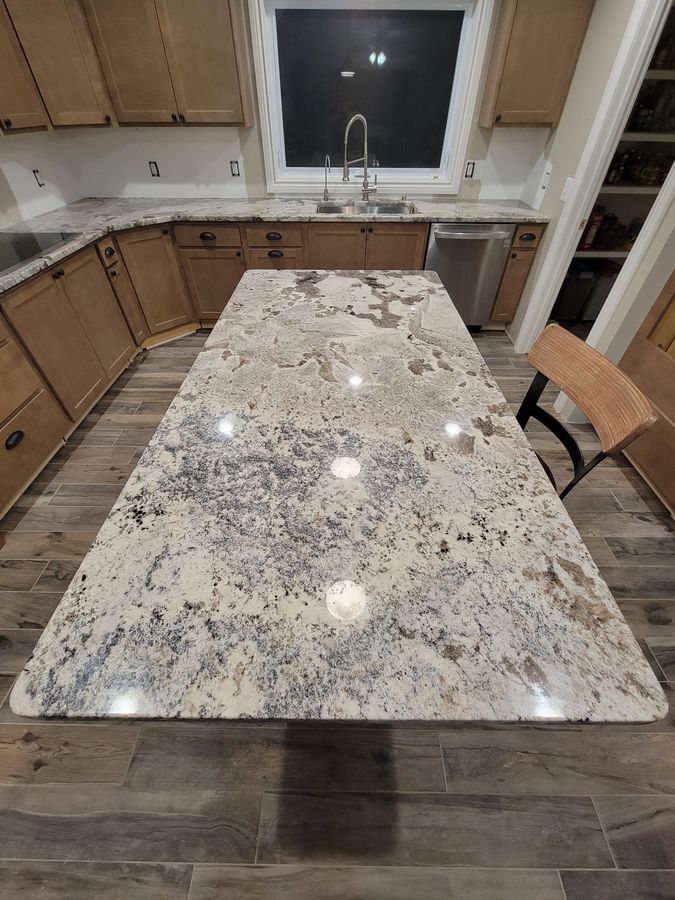
|
| Mineral: | Granite |
| Locality: | | India |  |
|
| Dimensions: | Slab |
| Description: |
|
| Viewed: |
7784 Time(s) |
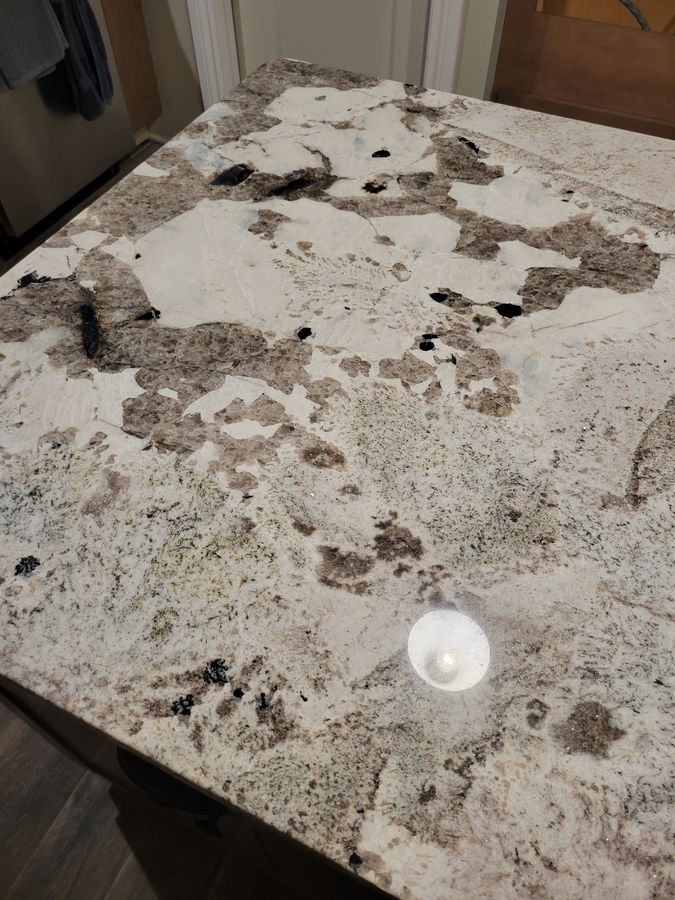
|
| Description: |
|
| Viewed: |
7794 Time(s) |
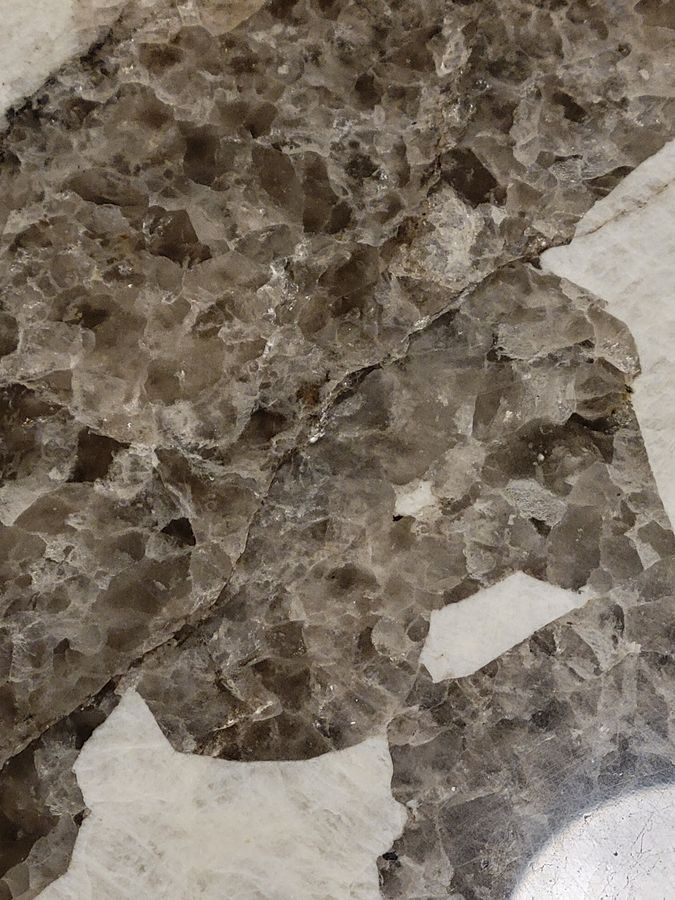
|
| Description: |
|
| Viewed: |
7796 Time(s) |
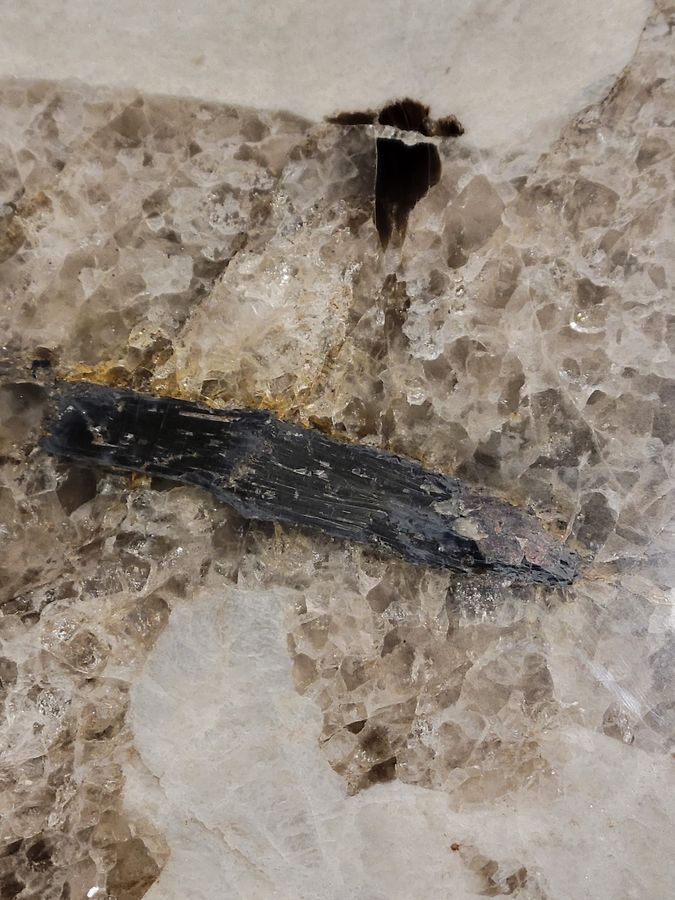
|
| Description: |
|
| Viewed: |
7797 Time(s) |
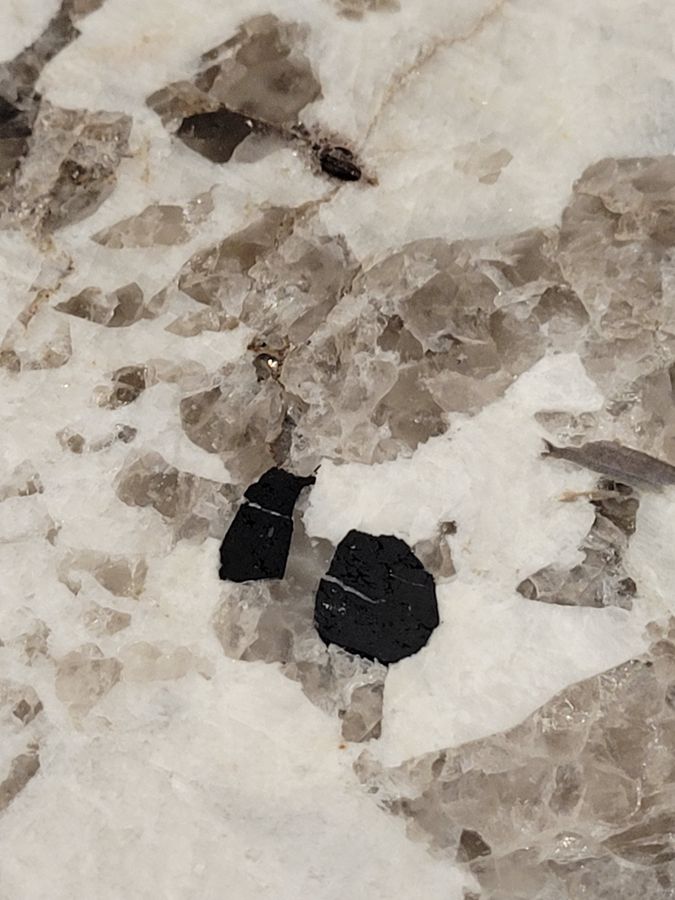
|
| Description: |
|
| Viewed: |
7796 Time(s) |
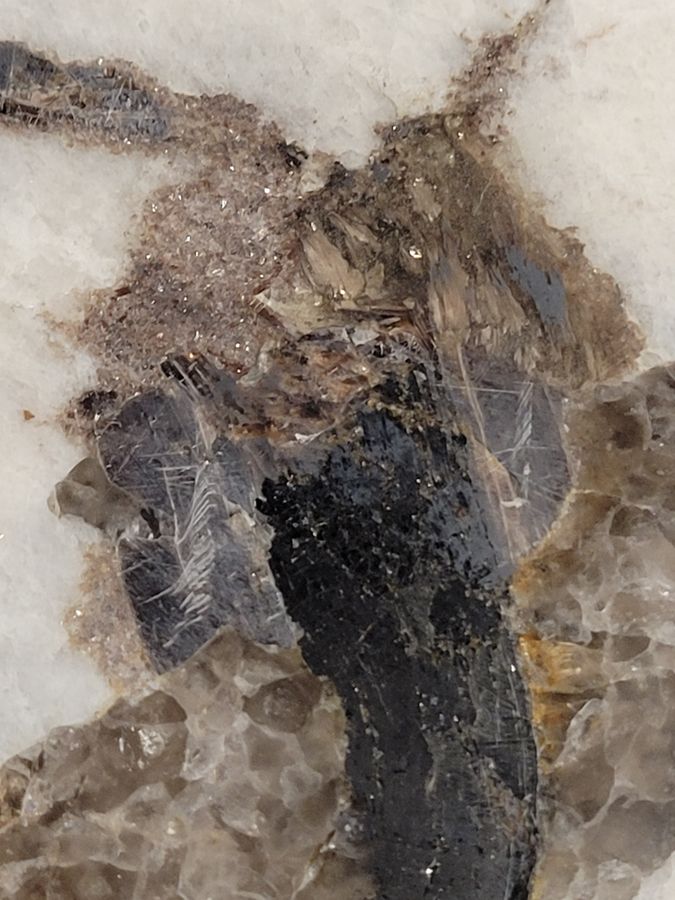
|
| Description: |
|
| Viewed: |
7799 Time(s) |
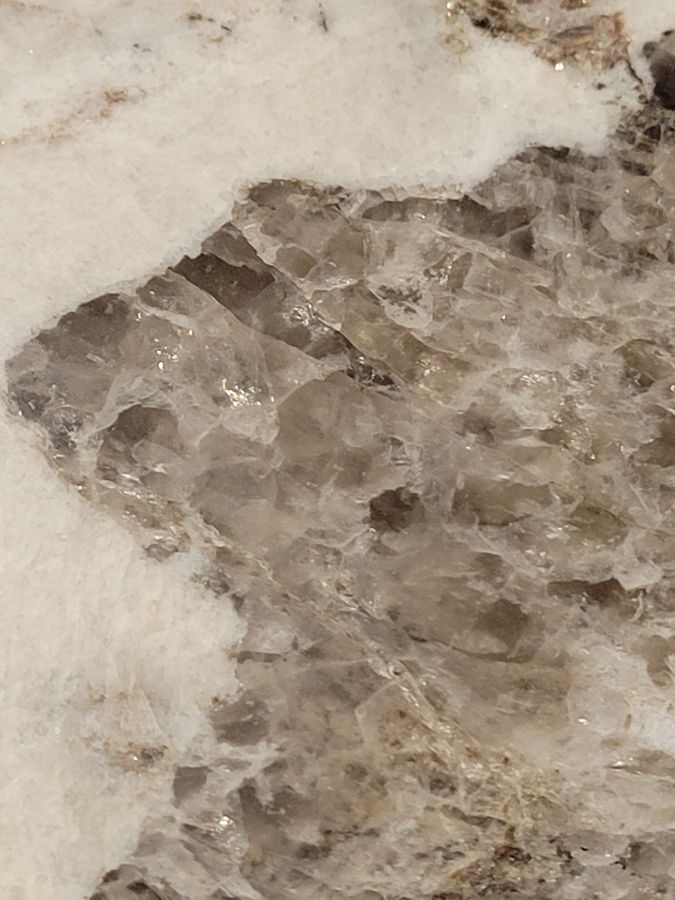
|
| Description: |
|
| Viewed: |
7797 Time(s) |
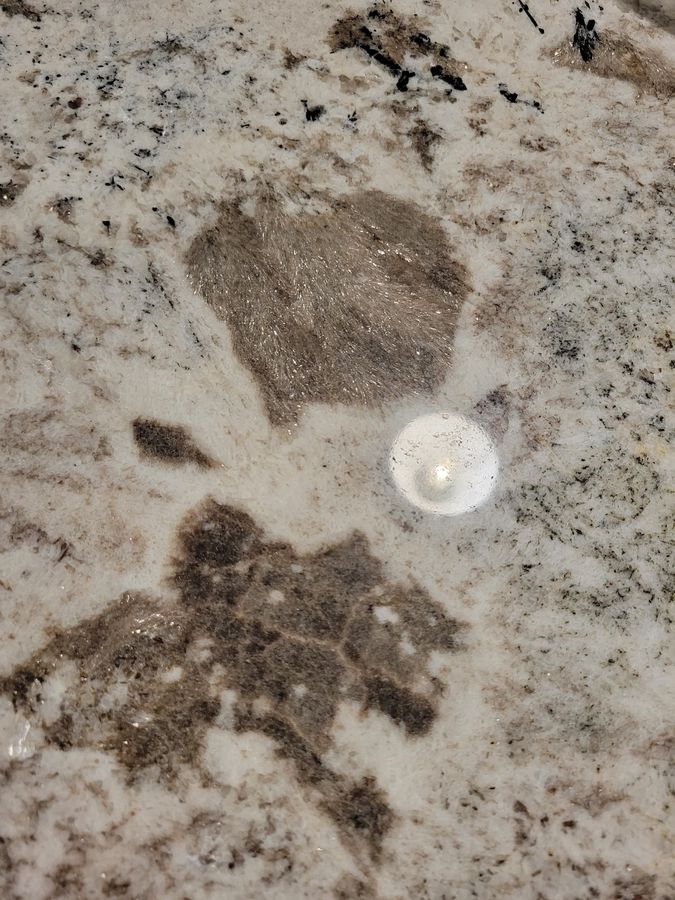
|
| Description: |
|
| Viewed: |
7794 Time(s) |
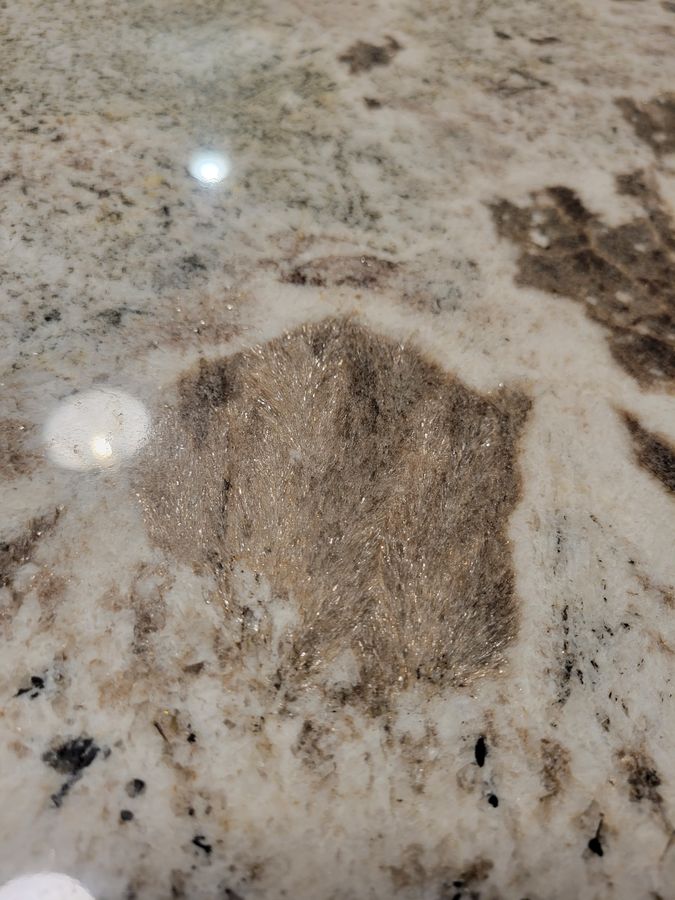
|
| Description: |
|
| Viewed: |
7791 Time(s) |
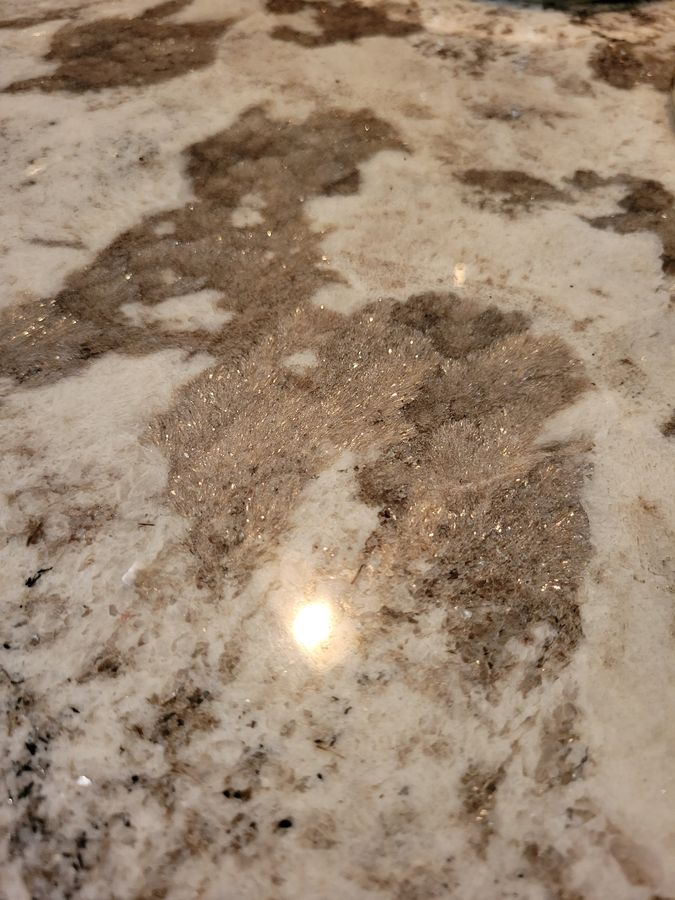
|
| Description: |
|
| Viewed: |
7799 Time(s) |
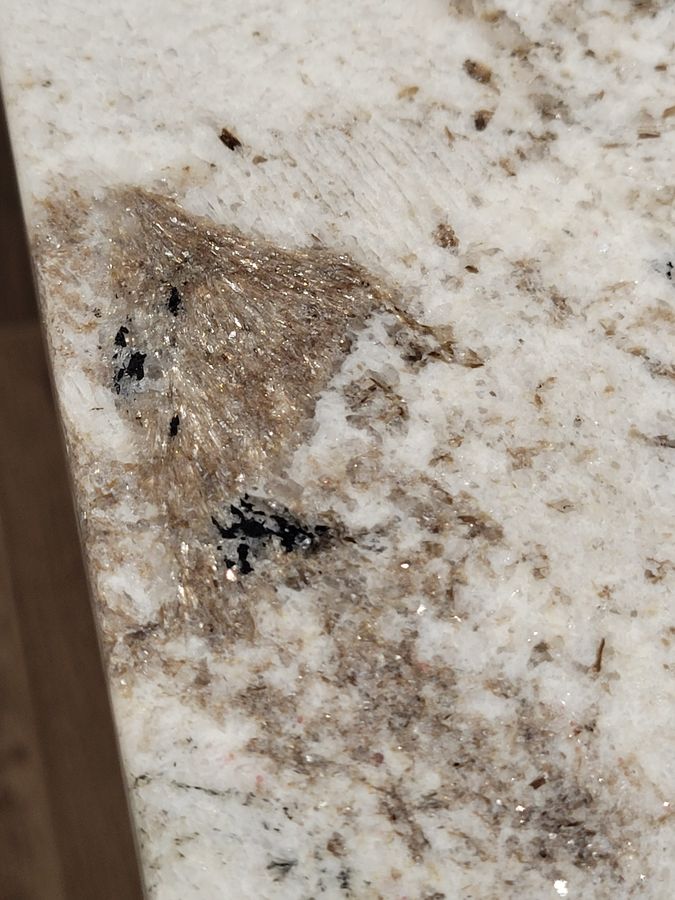
|
| Description: |
|
| Viewed: |
7789 Time(s) |
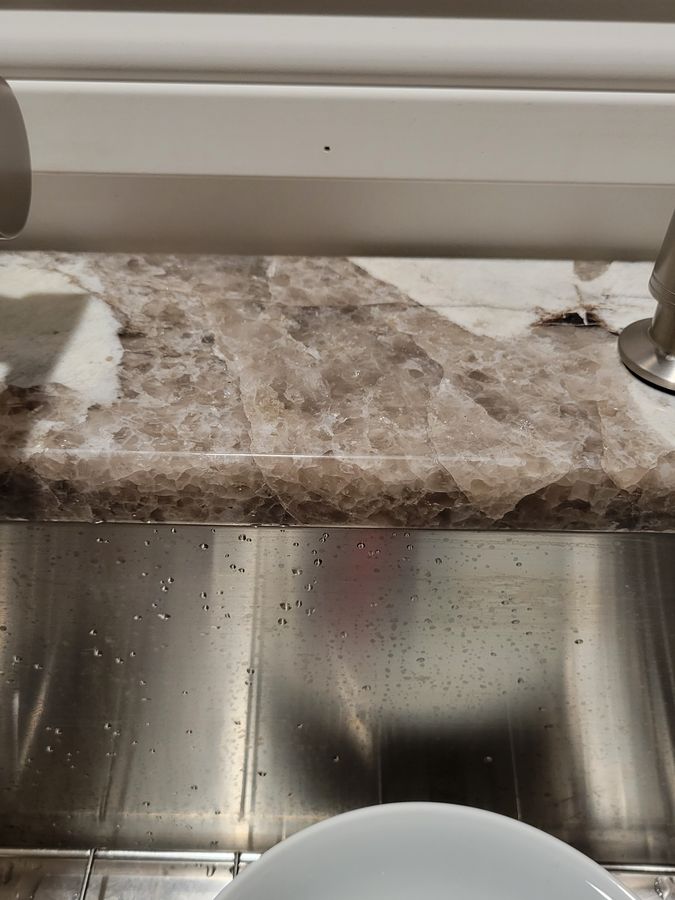
|
| Description: |
|
| Viewed: |
7784 Time(s) |
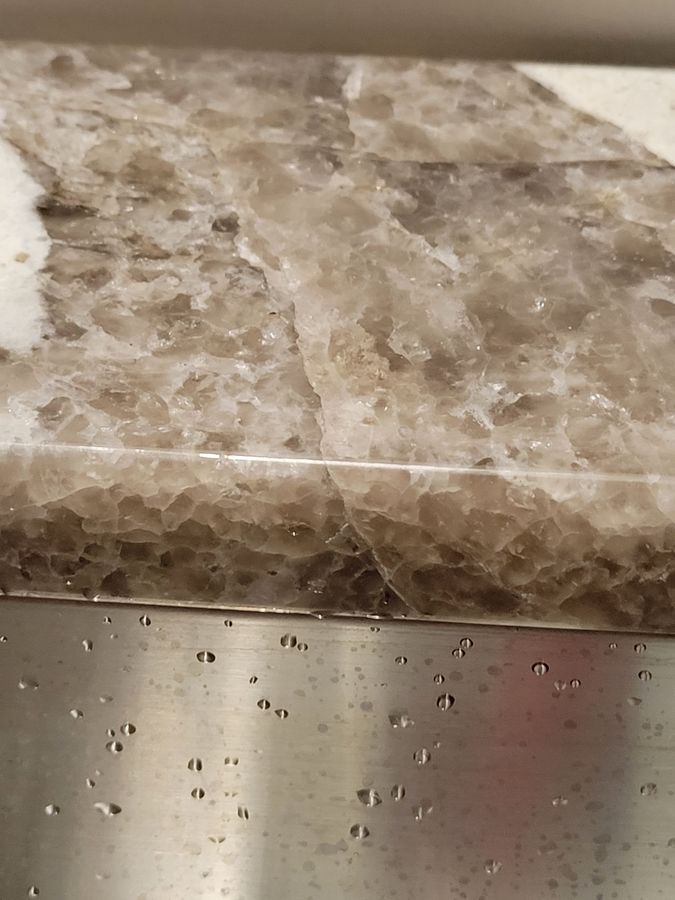
|
| Description: |
|
| Viewed: |
7792 Time(s) |
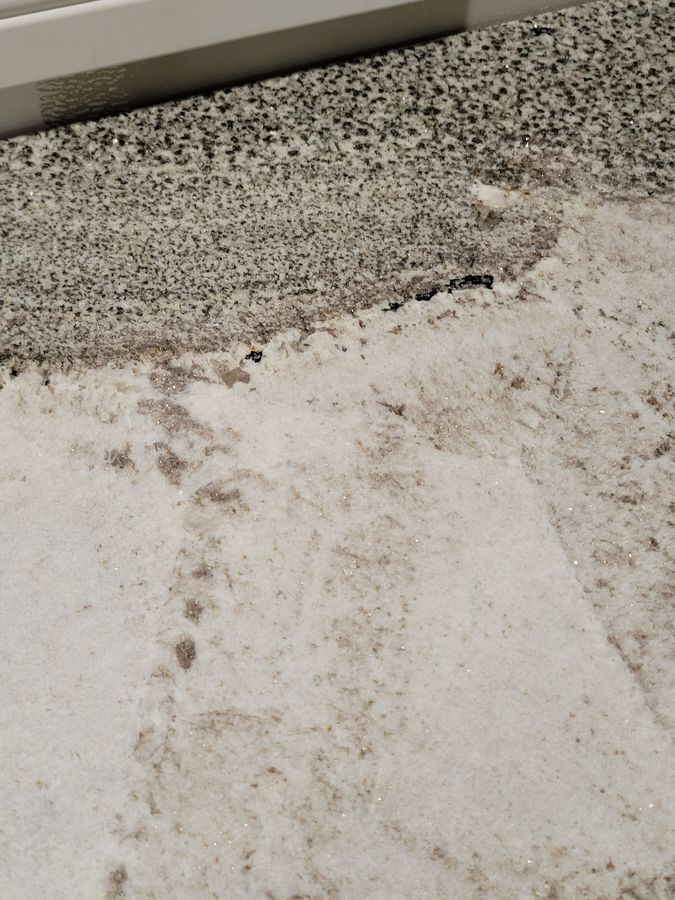
|
|
|
| Back to top |
|
 |
Matt_Zukowski
Site Admin
Joined: 10 Apr 2009
Posts: 737
Location: Alaska



|
 Posted: Oct 25, 2021 23:04 Post subject: Re: Please help identify the composition of this granite Posted: Oct 25, 2021 23:04 Post subject: Re: Please help identify the composition of this granite |
|
|
The mottled grey mineral in 20211025_215604.jpg and 20211025_215836.jpg is quartz.
The golden platy mineral in 20211025_215743.jpg and 20211025_215815.jpg is muscovite.
The black platy-looking mineral in 20211025_215506.jpg is biotite if it is indeed platy.
The black mineral in 20211025_215527.jpg could be biotite or hornblend. One of black minerals in this picture looks like it could have a hexagonal shape, which would suggest tourmaline, but i doubt it - it is probably the same mineral as the black more tabular mineral next to it.
The white material is feldspar.
|
|
| Back to top |
|
 |
Peter Lemkin
Joined: 18 Nov 2016
Posts: 403
Location: Prague


|
 Posted: Oct 26, 2021 01:14 Post subject: Re: Please help identify the composition of this granite Posted: Oct 26, 2021 01:14 Post subject: Re: Please help identify the composition of this granite |
|
|
While it is granite, it is a slice through a special type of granite called a pegmatite. I suggest you look that up on the internet. There are different types of pegmatites and different minerals in different pegmatites [or areas of one pegmatite], the basic feature is very large grain/crystal size and a concentration of some rare elements and compounds. I have a whole library on pegmatites. If you are really interested in knowing about your tabletop and have a scientific background, I can give you a few references that are fairly technical; but you will find a lot about pegmatites on the internet. They are one of the most fascinating mineralogical formations and where many [not all by far] nice and large mineral specimens/crystals come from. When I go out collecting minerals I often head to pegmatites. Your table may just start you in the direction of mineral collecting......
Technical, but about the best single book on the subject [IMHO], is Pegmatites by
David London Volume 10, 2008
ISBN: 978-0-921294-47-4
Pegmatites gives us an excellent and thorough review of the current state of the art in pegmatite studies.
In Part I, Geology, London provides a primer on the mineralogy, geology, and classification of pegmatites. But the center of gravity of this treatise is in Part II, Origins, which consolidates London’s petrological model of internal pegmatite evolution, and compares it with other concepts.
https://www.mineralogicalassociation.ca/publications/special-publications/sp10/
(link normalized by FMF)
But there are many books and articles for the lay reader on the subject and perhaps the best place to start. If and when you can read and understand London's book, you could write your own book just about your tabletop.
|
|
| Back to top |
|
 |
James Catmur
Site Admin

Joined: 14 Sep 2006
Posts: 1470
Location: Cambridge



|
|
| Back to top |
|
 |
tsaintonge
Joined: 25 Oct 2021
Posts: 3
Location: Detroit


|
 Posted: Oct 26, 2021 08:46 Post subject: Re: Please help identify the composition of this granite Posted: Oct 26, 2021 08:46 Post subject: Re: Please help identify the composition of this granite |
|
|
Thanks guys - some great info so far.
Matt - you pointed out that the Gold sections appear to be muscovite, and from looking at images, I agree!
Peter, I looked up some images and tried to find info pertaining to this slab ... based on what you said (and Matt pointed out) I believe it's 'possible' that this piece may have been sourced from/near Andhra Pradesh, India. Looks like there's a large quarry industry near there.
So my own kids, and my wife for her class, have some follow up questions. Based on the type of minerals found grouped together in this specific slab... and without carbon dating... is it possible to get obtain a more specific location of where the piece was sourced, and/or, a general age of the material? I'm sure that a chunk of muscovite compared to another, without specific testing, would be indistinguishable. However, when looking at this piece as a whole, and considering the materials contained together, are you able to make an educated guess?
And, is there a type of geological activity (specific) that would have been occurring at the time, to have created this specific group of minerals to combine and form this section?
--- I know that's a lot of questions, but this simple 'granite' slab has really sparked some interest!
|
|
| Back to top |
|
 |
Peter Lemkin
Joined: 18 Nov 2016
Posts: 403
Location: Prague


|
 Posted: Oct 26, 2021 09:49 Post subject: Re: Please help identify the composition of this granite Posted: Oct 26, 2021 09:49 Post subject: Re: Please help identify the composition of this granite |
|
|
| tsaintonge wrote: | Thanks guys - some great info so far.
Matt - you pointed out that the Gold sections appear to be muscovite, and from looking at images, I agree!
Peter, I looked up some images and tried to find info pertaining to this slab ... based on what you said (and Matt pointed out) I believe it's 'possible' that this piece may have been sourced from/near Andhra Pradesh, India. Looks like there's a large quarry industry near there.
So my own kids, and my wife for her class, have some follow up questions. Based on the type of minerals found grouped together in this specific slab... and without carbon dating... is it possible to get obtain a more specific location of where the piece was sourced, and/or, a general age of the material? I'm sure that a chunk of muscovite compared to another, without specific testing, would be indistinguishable. However, when looking at this piece as a whole, and considering the materials contained together, are you able to make an educated guess?
And, is there a type of geological activity (specific) that would have been occurring at the time, to have created this specific group of minerals to combine and form this section?
--- I know that's a lot of questions, but this simple 'granite' slab has really sparked some interest! |
Carbon dating is only for organic materials less than about 45-55,000 years old.
Yes, there are some very very sophisticated techniques to have mineral samples located as where they are LIKELY from - but you can't afford them, nor would the laboratories that do that at universities be interested. Only doing your own homework based on the way it looks, size of components and mix of components will you be able to GUESS where it is from, roughly. If you think it came from a specific quarry, send them a picture and hope they write back - or phone them and send the photo to the head phoobah there.
Some of your other questions all have answers, but it would take a full length mineralogy and petrology and geology course [3] to begin to answer to your satisfaction. I don't think many here would want to say much more than 'yes'. However, it looks like a fairly common pegmatite - but know there are many different types of pegmatite and even many different types of fairly common ones [with different features and combination of minerals]. Know also that the next slabs in all three spatial dimensions may have looked different and the further away from yours, the more different. It is a complex topic and you think simple answers will suffice. The easy way to tell the age of a mineralogical sample is first to know where it is from. Then usually [not always] some geologist has already done that work for you [determined its approximate age]...but know that pegmatites are usually intrusive [having forced their way into an older rock formation along cracks/faults - or creating their own by dynamic forces]....so unless some geologist has done the work to try to determine the age of that intrusive, it is only a rough guess.
The entire matter is more complex than I am making it and more complex than you and your family know...but keep digging...best on your own IMO.
|
|
| Back to top |
|
 |
tsaintonge
Joined: 25 Oct 2021
Posts: 3
Location: Detroit


|
 Posted: Oct 26, 2021 09:58 Post subject: Re: Please help identify the composition of this granite Posted: Oct 26, 2021 09:58 Post subject: Re: Please help identify the composition of this granite |
|
|
| Peter Lemkin wrote: | | tsaintonge wrote: | Thanks guys - some great info so far.
Matt - you pointed out that the Gold sections appear to be muscovite, and from looking at images, I agree!
Peter, I looked up some images and tried to find info pertaining to this slab ... based on what you said (and Matt pointed out) I believe it's 'possible' that this piece may have been sourced from/near Andhra Pradesh, India. Looks like there's a large quarry industry near there.
So my own kids, and my wife for her class, have some follow up questions. Based on the type of minerals found grouped together in this specific slab... and without carbon dating... is it possible to get obtain a more specific location of where the piece was sourced, and/or, a general age of the material? I'm sure that a chunk of muscovite compared to another, without specific testing, would be indistinguishable. However, when looking at this piece as a whole, and considering the materials contained together, are you able to make an educated guess?
And, is there a type of geological activity (specific) that would have been occurring at the time, to have created this specific group of minerals to combine and form this section?
--- I know that's a lot of questions, but this simple 'granite' slab has really sparked some interest! |
Carbon dating is only for organic materials less than about 45-55,000 years old.
Yes, there are some very very sophisticated techniques to have mineral samples located as where they are LIKELY from - but you can't afford them, nor would the laboratories that do that at universities be interested. Only doing your own homework based on the way it looks, size of components and mix of components will you be able to GUESS where it is from, roughly. If you think it came from a specific quarry, send them a picture and hope they write back - or phone them and send the photo to the head phoobah there.
Some of your other questions all have answers, but it would take a full length mineralogy and petrology and geology course [3] to begin to answer to your satisfaction. I don't think many here would wan to say much more than 'yes'. However, it looks like a fairly common pegmatite - but know there are many different types of pegmatite and even many different types of fairly common ones [with different features and combination of minerals]. Know also that the next slabs in all three spacial dimensions may have looked different and the further away from yours, the more different. It is a complex topic and you think simple answers will suffice. The easy way to tell the age of a mineralogical sample is first to know where it is from. Then usually [not always] some geologist has already done that work for you [determined its approximate age]...but know that pegmatites are usually intrusive [having forced their way into an older rock formation along cracks/faults - or creating their own by dynamic forces]....so unless some geologist has done the work to try to determine the age of that intrusive, it is only a rough guess.
The entire matter is more complex than I am making it and more complex than you and your family know...but keep digging...best on your own IMO. |
Thanks for that reply - and that makes perfect sense. Geology is NOT my field so, no joke, speaking to me as if I'm a 5th grader would probably provide the best info.
Specific to what you said about pegmatites being intrusive... I find that very interesting and that is something I was not aware of. In layman terms, does that then mean that the minerals seeped into the structure of other material, and then "grew" (as a crystal, in the case of my specific photos) into the cracks of that other material? Looking at the pictures, could you venture a guess as to what (if present) the "source" or "host" material would have been?
I can foresee these countertops being a conversation piece... I'd like to have some relevant, not overly-complex answers to provide.
Thanks again
|
|
| Back to top |
|
 |
Peter Lemkin
Joined: 18 Nov 2016
Posts: 403
Location: Prague


|
 Posted: Oct 26, 2021 10:08 Post subject: Re: Please help identify the composition of this granite Posted: Oct 26, 2021 10:08 Post subject: Re: Please help identify the composition of this granite |
|
|
Sorry, you think your questions have simple or short answers. Most do not. I am not going to try to explain 'intrusives' or pegmatitic intrusives. There are papers, books and I'm sure websites on that. Maybe someone else here has the energy for that question. I do not.
My final response to you would be to go to a very important website and start on this page: https://www.mindat.org/loc-24472.html
It shows 75 important mineral locations in that state of India...I'm sure not all pegmatites, but look through them and find those that are and see what you can find out using the internet. Lovely photos and other information is available on that website [and others].
You might try putting 'pegmatites of Andreh Predesh' and see what you find.
Good luck. Rome was not built in a day, and by the end of this day you will not know all there is to know about pegmatites I'm afraid. They have been my interest for 65 years.
|
|
| Back to top |
|
 |
James Catmur
Site Admin

Joined: 14 Sep 2006
Posts: 1470
Location: Cambridge



|
 Posted: Oct 26, 2021 11:03 Post subject: Re: Please help identify the composition of this granite Posted: Oct 26, 2021 11:03 Post subject: Re: Please help identify the composition of this granite |
|
|
| See if you can find a second-hand copy of 'Minerals: An Illustrated Exploration of the Dynamic World of Minerals and Their Properties', as I recall that it has a fairly good, but simple,explanation
|
|
| Back to top |
|
 |
|





